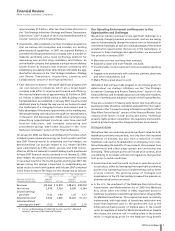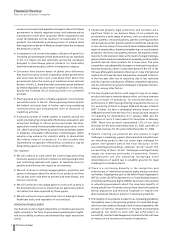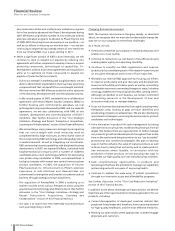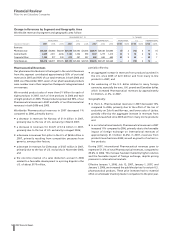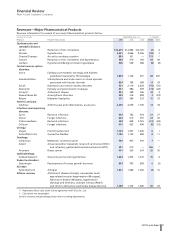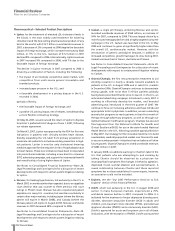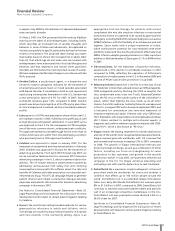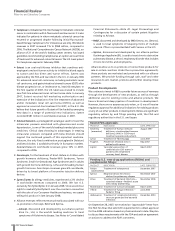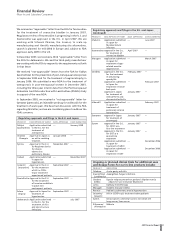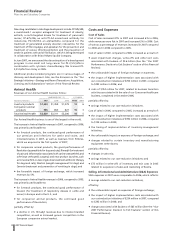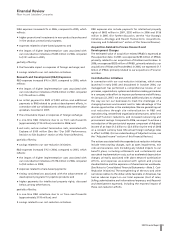Pfizer 2007 Annual Report Download - page 15
Download and view the complete annual report
Please find page 15 of the 2007 Pfizer annual report below. You can navigate through the pages in the report by either clicking on the pages listed below, or by using the keyword search tool below to find specific information within the annual report.
an in-depth review for impairment. We calculate the
undiscounted value of the projected cash flows associated with
the asset and compare this estimated amount to the carrying
amount of the asset. If the carrying amount is found to be
greater, we record an impairment loss for the excess of book
value over the asset’s fair value. Fair value is generally calculated
by applying an appropriate discount rate to the undiscounted
cash flow projections to arrive at net present value. In addition,
in all cases of an impairment review, we reevaluate the remaining
useful life of the asset and modify it, as appropriate.
•For indefinite-lived intangible assets, such as brands, each year
and whenever impairment indicators are present, we calculate
the fair value of the asset and record an impairment loss for the
excess of book value over fair value, if any. Fair value is generally
measured as the net present value of projected cash flows. In
addition, in all cases of an impairment review, we reevaluate
the remaining useful life of the asset and determine whether
continuing to characterize the asset as indefinite-lived is
appropriate.
•For Goodwill, which includes amounts related to our
Pharmaceutical and Animal Health segments, each year and
whenever impairment indicators are present, we calculate the
fair value of each business segment and calculate the implied
fair value of goodwill by subtracting the fair value of all the
identifiable net assets other than goodwill and record an
impairment loss for the excess of book value of goodwill over
the implied fair value, if any.
•For other long-lived assets, such as property, plant and
equipment, we apply procedures similar to those for finite-lived
intangible assets to determine if an asset is impaired. Long-term
investments and loans are subject to periodic impairment
reviews whenever impairment indicators are present. For these
assets, fair value is typically determined by observable market
quotes or the expected present value of future cash flows.
When necessary, we record charges for impairments of long-
lived assets for the amount by which the fair value is less than
the carrying value of these assets.
•For non-current deferred tax assets, we provide a valuation
allowance when we believe that the assets are not probable of
recovery based on an assessment of estimated future taxable
income that incorporates ongoing, prudent, feasible tax-
planning strategies.
The value of intangible assets is determined primarily using the
“income method,” which starts with a forecast of all the expected
future net cash flows (see the “Our Strategic Initiatives—Strategy
and Recent Transactions: Acquisitions, Licensing and
Collaborations,” section of this Financial Review). Accordingly, the
potential for impairment for these intangible assets may exist if
actual revenues are significantly less than those initially forecasted
or actual expenses are significantly more than those initially
forecasted. Further, an asset’s expected useful life can increase
estimation risk and, thus, impairment risk, as longer-lived
intangibles necessarily require longer-term forecasts—it should be
noted that for some assets these time spans can range up to 20
years or longer. Some of the more significant estimates and
assumptions inherent in the intangible asset impairment
estimation process include: the amount and timing of projected
future cash flows; the discount rate selected to measure the risks
inherent in the future cash flows; and the assessment of the
asset’s life cycle and the competitive trends impacting the asset,
including consideration of any technical, legal, regulatory or
economic barriers to entry, as well as expected changes in
standards of practice for indications addressed by the asset.
The implied fair value of goodwill is determined by first estimating
the fair value of the associated business segment. To estimate the
fair value of each business segment, we generally use the “market
approach,” where we compare the segment to similar businesses
or “guideline” companies whose securities are actively traded in
public markets or which have recently been sold in a private
transaction. We may also use the “income approach,” where we
use a discounted cash flow model in which cash flows anticipated
over several periods, plus a terminal value at the end of that time
horizon, are discounted to their present value using an
appropriate rate of return. Some of the more significant estimates
and assumptions inherent in the goodwill impairment estimation
process using the “market approach” include: the selection of
appropriate guideline companies; the determination of market
value multiples for the guideline companies and the subsequent
selection of an appropriate market value multiple for the business
segment based on a comparison of the business segment to the
guideline companies; and the determination of applicable
premiums and discounts based on any differences in ownership
percentages, ownership rights, business ownership forms, or
marketability between the segment and the guideline companies;
and/or knowledge of the terms and conditions of comparable
transactions. When considering the “income approach,” we
include the required rate of return used in the discounted cash
flow method, which reflects capital market conditions and the
specific risks associated with the business segment. Other estimates
inherent in the “income approach” include long-term growth rates
and cash flow forecasts for the business segment.
A single estimate of fair value results from a complex series of
judgments about future events and uncertainties and relies heavily
on estimates and assumptions (see “Estimates and Assumptions,”
above). The judgments made in determining an estimate of fair
value can materially impact our results of operations.
Pension and Postretirement Benefit Plans and Defined
Contribution Plans
We provide defined benefit pension plans and defined
contribution plans for the majority of our employees worldwide.
In the U.S., we have both qualified and supplemental (non-
qualified) defined benefit plans and defined contribution plans,
as well as other postretirement benefit plans, consisting primarily
of healthcare and life insurance for retirees. (See Notes to
Consolidated Financial Statements—Note 14. Pension and
Postretirement Benefit Plans and Defined Contribution Plans.)
The accounting for benefit plans is highly dependent on actuarial
estimates, assumptions and calculations, which result from a
complex series of judgments about future events and uncertainties
(see “Estimates and Assumptions,” above). The assumptions and
actuarial estimates required to estimate the employee benefit
obligations for the defined benefit and postretirement plans,
2007 Financial Report 13
Financial Review
Pfizer Inc and Subsidiary Companies


